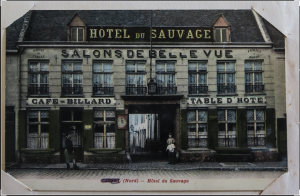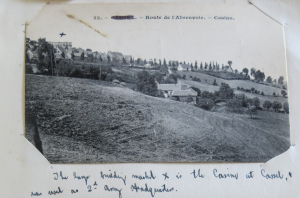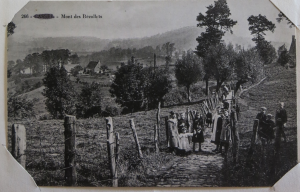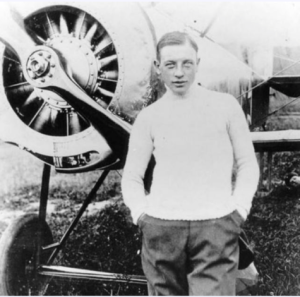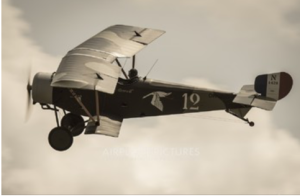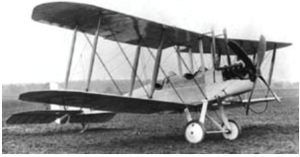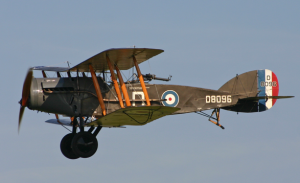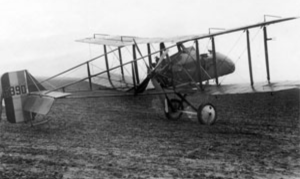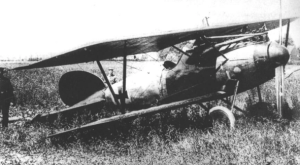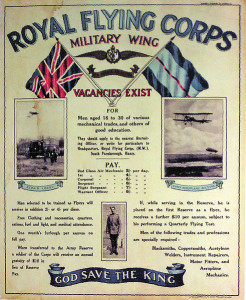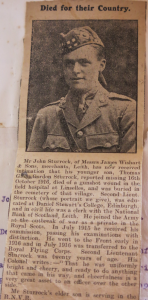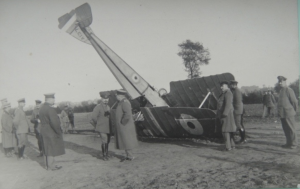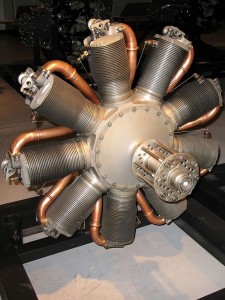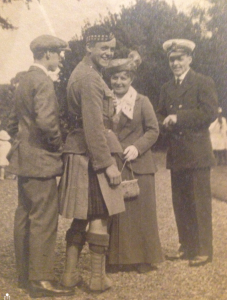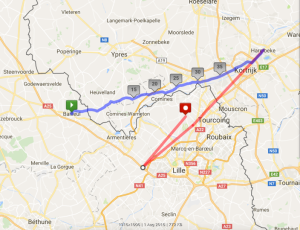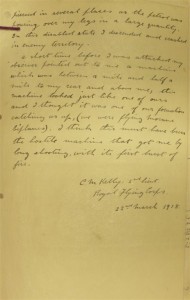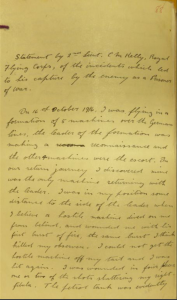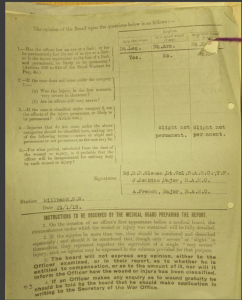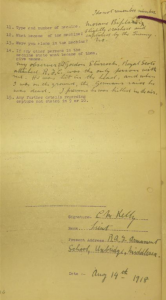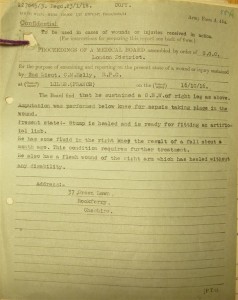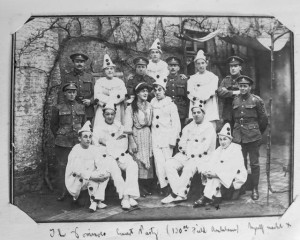Monthly Archives: October 2016
23rd to 26th October 1916
All material produced or reproduced here and throughout this work is the sole copyright of the author and the family of Doctor D.C.M. Page MC.
Rather oddly it would seem, Douglas Page although nearing the end of his contract and so approaching the end of his term of duty, was sent on a training course. Despatched to the 2nd Army Gas School at Oxelaëre near Cassel on the French side of the Franco Belgian border he was to receive valuable instruction of the latest defences against gas attack.
Douglas takes up the story:
“From October 23rd to 26th I attended a course of instruction in gas at the 2nd Army Gas School, Cassel. I went in a motor ambulance via Poperinghe. It was a lovely run on a sunny warm day. The actual school of instruction was about a mile out of Cassel – at the foot of the hill on which Cassel is situated. Oxalere was the name of the place, and here assembled about 9.30am a dozen of us – all doctors – from various Field Ambulances in the 2nd Army. Capt. Macalister – a Scot – was the Gas Officer, and he started off by giving us a 2 hours’ lecture on Cloud Gas etc. Afterwards we all went up the hill to Cassel, and were allotted our billets. I had a lovely room in a big chateau – quite the homeliest billet I’ve had since coming to France. After lunch at the ”Hotel Sauvage” some of us had a stroll round the town – a beautifully clean place on the top of a hill. We got lovely views of the surrounding country.
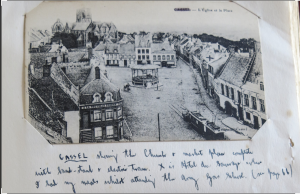
“Cassel showing the Church & market place complete with band-stand & electric tram. X is the Hotel Sauvage where I had my meals whilst attending the Army Gas School.”
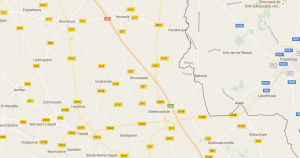
Cassel is in the south west of this map and Oxelaëre is just to the south west of Cassel. Poperinge can be seen to the east.
For three days we were instructed in gas warfare and were put through attacks during which chlorine, phosgene, and lachrymatory gases were used. It was most interesting work. We were supplied with new box respirators which acted admirably. On our last night we gave a dinner to our instructor. It was a most hilarious evening.
When I got back to the Field Ambulance I was kept busy for several days lecturing to the men on “Gas Warfare”, and instructing them in the use of the new respirator. I also put them through the test chamber – a hut filled with “tear” gas, and gave demonstrations of smoke and gas bomb attack. The latter demonstrations were most amusing affairs, and were very popular!”
Find out about our connection with Dr Page and an introduction to his diary here
Gordon Sturrock’s Vanquisher, Leutnant Alfred Ulmer of Jasta 8
All material produced or reproduced here and throughout this work is the sole copyright of the author and the family of Doctor D.C.M. Page MC.
Following the remarkable tale of the shooting down of Gordon Sturrock, here now is the story of his German adversary Leutnant Alfred Ulmer.
Two young men trying to achieve the same goal, but on opposite sides of the divide. Both were to come to a tragic end at such a young age.
Thanks must go to Mark Lubienski, a fellow Westminster Guide, for his interest and help. Mark also guides at Hendon’s R.A.F. Museum so I knew he could point me in the right direction and his help proved invaluable.
It was as recent as 1903, when famously the Wright brothers took to the skies in North Carolina on Dec 17th, in what was the first controlled, powered flight by a heavier than air machine. It was very soon realised that such aircraft could have a very important military role to play.
The British Army had realised the usefulness of powered aircraft and the Royal Flying Corp had emerged from a branch of the Royal Engineers, being formed in February 1912.
Having utilised lighter than air balloons as far back as the Napoleonic Wars, Germany’s hierarchy were quick to embrace the new fixed wing powered aircraft. Their fledgling air force Fliegertruppen des Deutschen Kaiserreiche or the Deutsche Luftstreitkräfte (Imperial German Airforce), was developed from both the German Army and Navy and had acquired its first fixed wing aircraft in 1910. Referred to as Die Fliegertruppe, both Army and Navy were responsible for observation balloons and the new fixed wing aircraft. Both the Navy and the Army took to the skies in “airships” which became known as Zeppelins though in 1915 the Zeppelins that launched the first air raids on England were crewed by Navy men complete with Navy uniforms. The Zeppelins were named after one of the two companies that developed them.
Leutnant Alfred Ulmer of Jasta 8.
Alfred Ulmer was born in the southern German town of Reutlingen, just south of Stuttgart, in the same year as Gordon Sturrock on September 15th 1896. Twenty years later, Alfred was the young man flying the “hostile machine” described by pilot Second Lt. C.M.Kelly.
Like so many young men Alfred was keen to grab the chance of the very new activity of flying. Just as Gordon had signed up with many others to defend King and Country, so did Alfred along with many compatriots keen to do their duty for the Kaiser and the Fatherland.
By October 1916, the German airforce had become known as “Deutsche Luftstreitkräfte”. Some sections were formed into hunter squadrons called Jagdstraffels, or simply Jastas. Lt. Albert Ulmer became a pilot in Jasta 8, flying an Albatros D.V F.E.2d, where he claimed a total of 5 kills including that of Gordon Sturrock. The only kill he had to his name before Sturrock and Charles Kelly was a couple of weeks earlier on the 1st October when he shot down an observation balloon at Oostviederen. After the Sturrock/Kelly victory, he went on to claim another three kills. On December 26th 1916 over Railway Wood near Ypres, he shot down a Nieuport 12 ser. no. A3294 flown by Capt. J.W.W. Nason and Lt. C.A. Felix-Brown of 46 Squadron. This was 46 Squadron’s first combat casualty.
Then on 24th January 1917, a freezing cold day with the ground covered with ice and snow from heavy snowfall in the previous week, Ulmer struck twice. At about 15.30 Royal Aircraft Factory B.E.2e number 6308 of 53 Squadron, crewed by Lt. T.F.Preston and Lt. C.M.Buck was shot down north of Warneton and later at about ten to five another Royal Aircraft Factory plane, this time F.E.8 number 6417 flown by 41 Squadron’s Sgt. Cecil Stephen Tooms (1678) aged 22, was brought down west of Wytschaete.
Ace Ulmer was then himself seriously wounded when on the 5th February 1917, 46 Squadron got their revenge when one of their Nieuport 12’s managed to shoot him down over Dranouter, Belgium. He survived the crash and slowly recovered enough from his injuries to terrorise the skies again. His reign came to an abrupt end on 29th June 1917 when he was shot down and killed over Houthem by Canadian ace Harold W. Joslyn, flying a Bristol F 2b for the RFC 20 Squadron.
Find out about our connection with Dr Page and an introduction to his diary here
16th October 1916 Monday
All material produced or reproduced here and throughout this work is the sole copyright of the author and the family of Doctor D.C.M. Page MC.
The week before reporting back on duty for the start of the Battle of the Somme, Douglas Page, after sampling the delights of London had spent the week at home in Edinburgh visiting his family.
Close family friends at the time were the Sturrocks of Leith. John and Annie M.M. Lloyd Sturrock had a proud young son Thomas Gibbs Gordon, known as Gordon. Gordon had a younger sister Elizabeth Mary, known as Elma, who was about five years younger than her brother. Whilst at home Douglas had enjoyed a long motor car joy ride with Mrs Sturrock, young Elma and his Mother. We haven’t as yet learned how they became betrothed, but in just over three years Douglas and Elma were to be married.
Meanwhile, like most young men of the time, Gordon Sturrock had enlisted to defend King and Country as a Second Lieutenant in the Royal Scots, 17th Battalion. He was gazetted as a temporary second lieutenant on the 1st July 1915. The 17th Battalion Royal Scots was raised as part of Kitchener’s new army following the setbacks of 1914.
It was a Bantams Battalion, for men that were perfectly able but lacked the minimum height requirements of the regular army, but officers of the Bantam regiments were usually of normal height.
The fledgling airborne service the Royal Flying Corps was busily recruiting men. This would come from two sources, from fresh recruits as they signed on for military service and from within the existing military, with men volunteering to join the new flying service. As the war progressed most recruits into the R.F.C. were recruited directly. Gordon however, was seconded to the R.F.C. from the Royal Scots and as 2nd Lieutenant became an observer officer.
In the late afternoon of Monday 16th October 1916, Gordon and his pilot 2nd Lieutenant Charles Moore Kelly prepared their Morane Saulnier BB, serial number A137 for a mission. This was a French built bi-plane with a crew of two and would fly to around 13,000 ft. Many were fitted with a front facing Lewis machine gun and could be used as a fighter as well as reconnaissance aircraft. The observers’ duties would be to navigate and to direct gunfire on the ground by observing the fall of artillery fire and redirecting as needed. They would also be responsible for the photographs that would prove invaluable in providing the information in planning battles etc.
Charles’ and Gordon’s Morane had been delivered at the end of April 1916 and was one of the type fitted with the more powerful Le Rhône 9J 110 hp engine. Many had to make do with a less powerful 80 hp version due to the wartime shortages.
Along with four other aircraft, they were to take part in escorting a reconnaissance mission to fly from Bailleul in what is now the Nord region of French Flanders, across to near the Belgian border, north of Lille, behind the German lines.
The group took off from their base in Bailleul and headed east toward the front line. The leader was to make the reconnaissance and the four other aircraft flying to the side and the rear were the protective escort. Writing in March 1918, 2nd Lieutenant Kelly tells us the story from there:
“On our return journey, I discovered mine was the only machine returning with the leader. I was in my position to the side and somewhat to the rear of the leader when I believe a hostile machine dived in on me from behind and wounded me with his first burst of fire, the same burst I think killed my observer. I could not get the hostile machine off my tail and I was hit again. I was wounded in four places, one or two of the shots shattering my right fibula. The petrol tank was evidently pierced in several places as the petrol was pouring over my legs in a large quantity. In this disabled state I descended and crashed in enemy territory.
A short time before I was attacked, my observer pointed out to me a machine which was between a mile and half a mile to the rear and above me, this machine looked just like one of ours and I thought it was one of our formation trying to catch up, (we were flying Morane bi-planes). I think this must have been the hostile machine that got me by long shooting, with its first burst of fire.”
The plane whilst losing so much fuel and clearly losing power, came down near the village of Linselles. Pilot Charles Kelly was captured alive and made a prisoner of war. Poor Gordon Sturrock it seems was dead from gunshot before the plane crashed. After being taken to hospital, where he was declared dead, he was buried in a communal cemetery in Linselles where he now remains in a plot maintained by the CWGC. A newspaper report of the incident suggests that Sturrock in fact died in hospital. Did he die on the way, was he dead on arrival, or a bit later on? We can’t without further investigation say for sure.
Find out about our connection with Dr Page and an introduction to his diary here
October 1916 (unspecified date)
All material produced or reproduced here and throughout this work is the sole copyright of the author and the family of Doctor D.C.M. Page MC.
“I spent one day at a nice little place called Wormhoudt. Capt. Ffoulkes was in charge of the Officers’ Corps Rest Station there, and I went to relieve him for the day. It was a nice run in the ambulance car via Watou, Houtkerque and Herzeele. The Rest Station was in a big chateau with lovely grounds, and I enjoyed my day there very much.
Our Concert Party had rehearsals two or three times a week and turned out to be quite a decent show. We gave humorous concerts at the various casualty clearing stations, and in neighbouring villages to other units. We were always very well received.
Trips into Poperinghe to replenish our mess stores helped to make life more pleasant. Usually we rode in on horse-back, and Elliot was my usual companion. Tea and dinner at the Club – in Skindles, was the usual programme and a visit to the cinema too helped to brighten up our young lives!”
Find out about our connection with Dr Page and an introduction to his diary here
